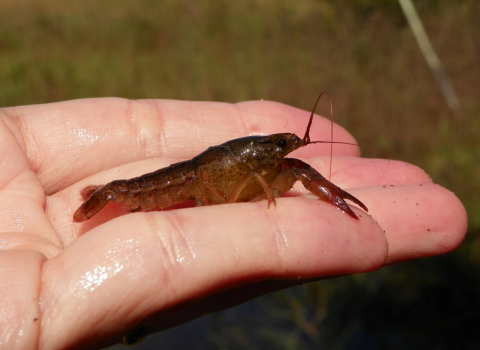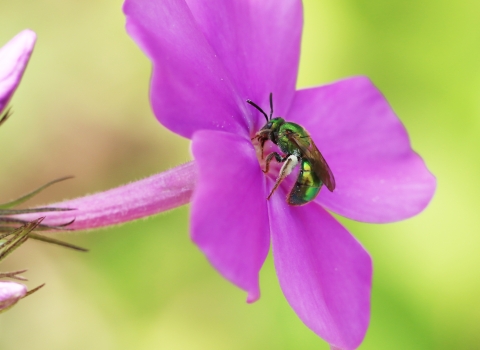Blogger’s note: People power conservation, and this series shines a spotlight on some of the folks working hard to protect the nature of America. Kim Flotlin, a wildlife biologist in our Washington Fish and Wildlife Office, has worked for the U.S. Fish and Wildlife Service for three decades and shares her story with us.
How did you become interested in a career in conservation?
I’ve had a long-standing love of all living things. When I started college, I was planning to be a veterinarian but when it came time to choose a major it seemed like wildlife biology was the one that chose me. All the classes in the major spoke to (nearly) every one of my favorite things. Wildlife ecology? Check. Wildlife nutrition? Yes, please! Comparative vertebrate anatomy, botany, animal behavior, wildlife management, population dynamics? Yes, yes, and yes! I loved those classes. I took every wildlife-related job I could during the summers and on weekends during the school year. That job experience set me up beautifully to qualify for wildlife jobs once I graduated. It took me about four years of seasonal and term work (with Washington Department of Fish and Wildlife and U.S. Forest Service) to get a permanent job with the U.S. Fish and Wildlife Service here in Washington, and I’ve been here ever since.
Do you have any mentors or conservation heroes?
I’ve been really lucky in my career to have had some awesome supervisors as mentors and conservation heroes. My first boss at the U.S. Forest Service was amazing at both. She believed so whole-heartedly in her staff; she challenged us to do the difficult things but supported us at all steps along the way. Her contagious love of wildlife and plants, and of always learning, inspired and entertained us. My first boss at the U.S. Fish and Wildlife Service was also an outstanding mentor. He and our field supervisor really modeled what excellent supervision looks like, backing their staff all the way up the chain of command, creating and encouraging connections between all office staff, providing the training we needed to get our jobs done well, and ultimately inspiring a can-do attitude that fostered creative, innovative work products.
How did you find your way to the U.S. Fish and Wildlife Service?
My first job out of college was a summer job with Washington Department of Fish and Wildlife (WDFW) studying upland sandpipers. My study site was about an hour’s drive from the office, and I had to be there before sunrise. My day’s work was over before noon! That was a fun job. Because I worked in the field all the time, I was able to bring my dog with me to work. Bonus! I also had a summer job with Washington Department of Natural Resources on a fire crew where I learned that fire, although a critical component of conservation, was not my calling. It’s helpful to know what you don’t want to do as a career, too! Finally, I got a seasonal job with the U.S. Forest Service, conducting spotted owl surveys. That morphed into a term job on the same ranger district, working as the lead biologist on an interdisciplinary team where I helped write a watershed analysis and was recruited to join the U.S. Fish and Wildlife Service.
Tell us about your job — what do you do at the U.S. Fish and Wildlife Office?
I currently work in the Washington Fish and Wildlife Office (WFWO), in Lacey, Washington. I’ve been at the WFWO in our Ecological Services program for my entire career, which started way back in 1991. A portion of my early career days were spent writing Habitat Conservation Plans (HCPs) and I am proud to say that I wrote the first two HCPs for Washington! Both of those plans were for the northern spotted owl, an iconic species and a complex issue for the Pacific Northwest. Today, my work is mostly listing and recovery related so I work on things like listing rules, critical habitat designations, recovery plan development, recovery funding, scientific permits, cooperative agreements, and mentoring new employees.
What do you think is the most interesting thing about your job?
Learning new things about plants and animals! I love learning new things, especially when it comes to the natural world. I love geeking out about the new things I learn with other biologists who are as interested in them as I am, who “get it.” That’s probably also the most surprising thing about my job — there’s always more to learn. You’d think that after more than 30 years I’d have run out of things to learn in my job, but that’s not the case. Through the years I’ve been fortunate to have worked on a variety of species, including northern spotted owl, marbled murrelet, Columbian white-tailed deer, streaked horned lark, four subspecies of Mazama pocket gopher, Oregon vesper sparrow, Mt. Rainier white-tailed ptarmigan, and most recently, two species of torrent salamander (Columbia and Cascade). Current work projects include finalizing the recovery plan for the four federally listed subspecies of Mazama pocket gopher, the listing rule for the Mt. Rainier white-tailed ptarmigan, a Species Status Assessment for two species of torrent salamander, and revision of the inland survey protocol for the marbled murrelet.
What’s your favorite thing about working for the U.S. Fish and Wildlife Service?
First and foremost, it’s the mission of the U.S. Fish and Wildlife Service. I could have made more money working in the private sector for a consulting firm, but I am a firm believer in our mission to conserve the nature of America. Secondly, it’s the people I work with. Everyone I work with has the same conservation ethic and love for nature that I do. I think it’s very rare to have a career where the vast majority of your coworkers think the same way you do about your field of work. It is what has kept me here, in this agency, for my entire career.
Which National Wildlife Refuge is your favorite?
For as many times as I’ve visited it, I’d have to say the Billy Frank Jr. Nisqually National Wildlife Refuge. It’s practically on the doorstep of my field office, and we’ve been fortunate in the past to hold staff meetings and trainings in their conference room. The view out the windows there is so distractingly pretty, they had to close the curtains during our meetings! My family and I often go there on weekends.
Why do you love that place?
I love the serenity and views you can experience, in a place that borders I-5 — it’s shocking, actually, that such beauty is smack adjacent to our state’s busiest highway. The boardwalk is definitely my favorite part of the refuge.
What advice do you have for someone interested in a career in conservation, public service, and/or with the U.S. Fish and Wildlife Service?
Volunteer, job shadow, and/or intern with as many people/places/agencies as you can throughout high school and college.
Take advantage of your high school and college career counseling resources, to find careers that may be of interest to you; there are many more careers in conservation than you know of, and the Service offers several of the multitude of options.
Join professional societies related to your area(s) of interest. Attend meetings if at all possible; this allows you to network with others in that field. Students are usually offered discounted membership and meeting attendance prices, scholarships, mentoring opportunities and more. These societies usually also post job information, including internships, volunteer or paid jobs, summer jobs, etc., that may or may not be posted anywhere else.
If you’re interested in federal government jobs, a great place to start is with USAJOBS. They have a students and grads webpage, too. OPM also has a students and grads page that explains the various programs offered by the government for current students or recent grads.
For jobs in all sectors, here’s a great job finder site.
Get your resume out there, but start smart by ensuring you maintain your cyber privacy. Then consider not only USAJOBS, but also sites such as LinkedIn, CareerBuilder, Resume Rabbit, or Monster, for getting your resume into the hands of those that are hiring.
Be patient and be persistent. Keep applying. Keep trying. The right job for you is out there, waiting!
To read this story on our Medium blog and see more photos of Kim in action, check it out here.




